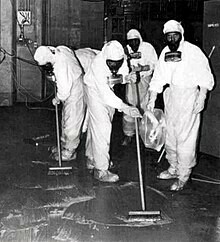Nuclear weapons and the environment

Jan. 22, 2023, marked the second anniversary of the Treaty on the Prohibition of Nuclear Weapons. On Jan. 22, 2021, nuclear weapons officially became illegal under international law.
The world community declared the mass murder resulting from using nuclear weapons a crime against humanity. Currently 92 nations have signed and ratified the treaty and are bound by its provisions.
Unfortunately, none of the nine countries who have nuclear weapons have signed and ratified the treaty. Because they have not, the treaty does not apply to them. As a result, human civilization and most, if not all, life on earth is still threatened by the existence of nuclear weapons.
I have written often about the dangers, destructiveness, waste, and insanity of nuclear weapons. There are many reasons why they must be abolished. Most obviously we cannot use them. They are militarily useless. They are the epitome of waste. There is no political, ideological or national security objective that would justify the horrendous destruction and loss of life of a nuclear war.
But even if nukes are never used they are extremely destructive.
Nuclear weapons are an environmental disaster. The entire process of making them, from mining the uranium to manufacturing the bombs, produces huge amounts of highly toxic, long-lasting substances.
Nuclear weapons production (and production of nuclear fuel for power plants) is the single most environmentally damaging human activity.
All mining is destructive and causes serious pollution. But mining uranium is much worse.
Uranium is a heavy metal but it is also radioactive. So there are all the usual problems with air, soil and water pollution from mining and ore processing activities, plus the waste and byproducts are radioactive. Nukes are a double whammy for the environment.
From our human perspective this radioactivity will essentially last forever. The half life of uranium-238, the isotope in uranium ore, is 4.5 billion years. The half life of uranium-235, used in bombs, is 700 million years.
Plutonium-239 is made from uranium and is the core of most nuclear weapons. Plutonium is an artificial, man-made element. It doesn’t exist in nature. It has a half-life of 24,000 years. Any given quantity of it will decrease (or decay) by half every 24,000 years. This means that after 96,000 years you will still have 1/16 of the amount you started with.
Mining for any metals takes digging up a lot of “overburden” (rock and soil) to find a smaller amount of ore which, after processing, produces a tiny amount of the target metal.
Uranium concentration in uranium ore varies significantly. One source cited below says 10,000 tons of raw ore will yield 1 ton of uranium “yellowcake” that produces 7.11 kilograms of uranium-235.
Typically 99.9 percent of uranium ore is left behind as waste.
Worldwide there are approximately 350,000 tons of highly radioactive waste awaiting safe storage. This does not include mining tailings and waste dumps at uranium mines.
No country has opened a safe nuclear waste storage site for this radioactive waste.
Processing of uranium ore into usable isotopes (uranium-235 and plutonium-239) and needed concentrations (called enrichment) uses huge amounts of water. It also leaves behind huge amounts of water contaminated with radioactivity and other toxic elements and chemical compounds.
Nuclear contamination in soil and groundwater is very difficult and expensive to clean up, and there are no safe long term storage solutions for nuclear waste.
All Department of Energy nuclear weapons facilities have contaminated the air, ground water, surface water and surrounding vegetation and wildlife.
There are 14 Department of Energy nuclear weapons production facilities (both open and closed) in 13 states. There are 17 nuclear research laboratories scattered across the country.
The now closed Hanford Nuclear Reservation in Washington is the worst. Located on the Columbia River, it produced plutonium from 1943 to 1987. The facility used Columbia River water to cool eight nuclear reactors, returning radioactive water to the river.
The Hanford “tank farm” has 53 million gallons of radioactive and toxic hazardous waste in 177 tanks. Many of these are leaking and 50 of them pose a present threat of explosion due to a gaseous build-up in the tanks. Hanford is the the worst Superfund pollution clean-up site in the country.
Radioactivity released from atmospheric testing during the Cold War has been dispersed across the world. Radioactive fallout has impacted people downwind from the test sites and from accidents at production facilities.
Several radioactive isotopes (strontium-90 and cesium-137 ) are found in virtually everyone’s teeth, bones and bodies. Strontium-90 is in breast milk.
Nuclear weapons are uniquely harmful to our health and environment. There is no safe level of exposure to radiation. Radiation is carcinogenic and can produce genetic mutations.
Toxic heavy metals and other chemical pollution from nuclear weapons production are also carcinogenic. So why do we continue to produce these highly toxic materials?
One might argue that mining uranium for nuclear power plants might be worth the risk. I do not agree with this argument, but there are no good arguments for nuclear weapons. There is no national security objective worth the environmental cost of producing these unusable weapons. They are 100% pure waste.
It does not matter whether Mutually Assured Destruction (MAD) prevented a nuclear war or enhanced our national security during the Cold War. Today
MAD is a dangerous, insane policy. Just because we somehow avoided nuclear holocaust in the past doesn’t mean playing nuclear chicken is good military or foreign policy.
Rather than recognizing the uselessness of nuclear weapons our government plans to spend $2 trillion on completely rebuilding the entire arsenal, the delivery systems and the manufacturing facilities. This will only result in more toxic, radioactive waste. It will only result in a new, costly nuclear arms race.
The Treaty on the Prohibition of Nuclear Weapons offers the opportunity for the United States and the other nuclear weapons countries to completely abolish nuclear weapons. This won’t abolish the past or ongoing, environmental damage from nuclear weapons.
But we can at least stop digging the nuclear hole deeper.
To learn more about uranium mining and it impact on people see the report “Uranium Atlas” at beyondnuclear.org/a-map-of-our-nuclear-nightmare.
